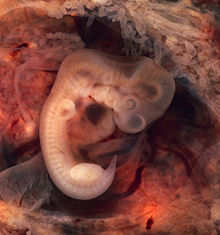격세유전
격세유전(隔世遺傳, atavism)은 생물학에서 조상의 유전적 형질이 이전 세대들의 진화적 변화를 통해 소실된 이후 다시 나타나는 생물학적 구조의 수정이다.[1] 격세유전은 여러 방식으로 발생할 수 있다.[2] 그 중 하나는 유전자가 과거에 있던 기존 표현형적 특징이 DNA에 보존되어 있을 때 이것들이 새로운 기질에 대해 우세한 유전자를 무릎꿇리거나 오래된 기질이 새로운 것을 지배하는 돌연변이를 통해 표현될 수 있다는 것이다.[1] 격세유전은 진화의 증거로 간주되기도 한다.[3][4]

사회과학에서 격세유전은 회귀의 경향이다. 예를 들어 현대시대의 사람들이 과거의 생각과 행동방식으로 회귀하는 경향을 들 수 있다.
각주
편집- ↑ 가 나 Brian K. Hall (1984), “Developmental mechanisms underlying the atavisms”, 《Biological Reviews》 59 (1): 89–124, doi:10.1111/j.1469-185x.1984.tb00402.x, PMID 6367843, S2CID 29258934
- ↑ Tomic, Nenad; Meyer-Rochow, Victor Benno (2011). “Atavisms - medical, genetic, and evolutionary implications”. 《Perspectives in Biology and Medicine》 54 (3): 332–353. doi:10.1353/pbm.2011.0034. PMID 21857125. S2CID 40851098.
- ↑ Brian K. Hall (1995), “Atavisms and atavistic mutations”, 《Nature Genetics》 10 (2): 126–127, doi:10.1038/ng0695-126, PMID 7663504, S2CID 27868367
- ↑ Raynauad, A. (1977), 《Somites and early morphogenesis in reptile limbs. In Vertebrate Limb and Somite Morphogenesis》, Cambridge University Press, London, 373–386쪽
외부 링크
편집- Bar-Maor, JA; Kesner, KM; Kaftori, JK (November 1980). “Human tails”. 《The Journal of Bone and Joint Surgery. British Volume》 62–B (4): 508–510. doi:10.1302/0301-620x.62b4.7430236. PMID 7430236.
- Photograph of an additional (third) hoof of cows